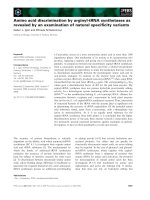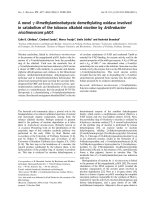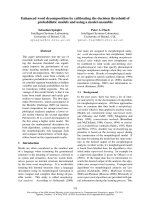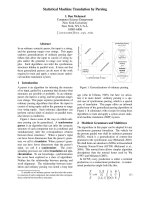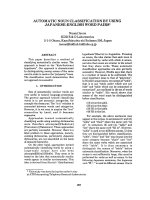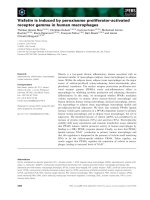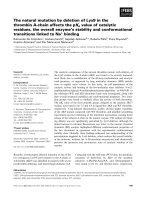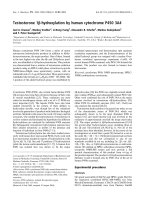Báo cáo khoa học: " PET/CT Staging Followed by Intensity-Modulated Radiotherapy (IMRT) Improves Treatment Outcome of Locally Advanced Pharyngeal Carcinoma: a matched-pair comparison" pps
Bạn đang xem bản rút gọn của tài liệu. Xem và tải ngay bản đầy đủ của tài liệu tại đây (454.45 KB, 10 trang )
BioMed Central
Page 1 of 10
(page number not for citation purposes)
Radiation Oncology
Open Access
Research
PET/CT Staging Followed by Intensity-Modulated Radiotherapy
(IMRT) Improves Treatment Outcome of Locally Advanced
Pharyngeal Carcinoma: a matched-pair comparison
Sacha Rothschild
1,2
, Gabriela Studer
1
, Burkhardt Seifert
3
, Pia Huguenin
4
,
Christoph Glanzmann
1
, J Bernard Davis
1
, Urs M Lütolf
1
, Thomas F Hany
5
and I Frank Ciernik*
6,7
Address:
1
Radiation Oncology, Zurich University Hospital, Rämistrasse 100, 8091, Zurich, Switzerland,
2
Medical Oncology, Kantonsspital Aarau,
Tellstrasse, 5001, Aarau, Switzerland,
3
Institute for Social- and Preventive Medicine, University of Zurich, Hirschengraben 84, 8001 Zurich,
Switzerland,
4
Radiation Oncology, Kantonsspital Graubünden, Loëstrasse 107, 7000 Chur, Switzerland,
5
Nuclear Medicine, Zurich University
Hospital, Rämistrasse 100, 8091, Zurich, Switzerland,
6
Center for Clinical Research, Zurich University Hospital, Rämistrasse 100, 8091, Zurich,
Switzerland and
7
Oncology Institute of Southern Switzerland, Ospedale San Giovanni e Valli, 6500 Bellinzona, Switzerland
Email: Sacha Rothschild - ; Gabriela Studer - ; Burkhardt Seifert - ;
Pia Huguenin - ; Christoph Glanzmann - ; J Bernard Davis - ;
Urs M Lütolf - ; Thomas F Hany - ; I Frank Ciernik* -
* Corresponding author
Abstract
Background: Impact of non-pharmacological innovations on cancer cure rates is difficult to assess.
It remains unclear, whether outcome improves with 2- [18-F]-fluoro-2-deoxyglucose-positron
emission tomography and integrated computer tomography (PET/CT) and intensity-modulated
radiotherapy (IMRT) for curative treatment of advanced pharyngeal carcinoma.
Patients and methods: Forty five patients with stage IVA oro- or hypopharyngeal carcinoma
were staged with an integrated PET/CT and treated with definitive chemoradiation with IMRT from
2002 until 2005. To estimate the impact of PET/CT with IMRT on outcome, a case-control analysis
on all patients with PET/CT and IMRT was done after matching with eighty six patients treated
between 1991 and 2001 without PET/CT and 3D-conformal radiotherapy with respect to gender,
age, stage, grade, and tumor location with a ratio of 1:2. Median follow-up was eighteen months
(range, 6–49 months) for the PET/CT-IMRT group and twenty eight months (range, 1–168 months)
for the controls.
Results: PET/CT and treatment with IMRT improved cure rates compared to patients without
PET/CT and IMRT. Overall survival of patients with PET/CT and IMRT was 97% and 91% at 1 and
2 years respectively, compared to 74% and 54% for patients without PET/CT or IMRT (p = 0.002).
The event-free survival rate of PET/CT-IMRT group was 90% and 80% at 1 and 2 years respectively,
compared to 72% and 56% in the control group (p = 0.005).
Conclusion: PET/CT in combination with IMRT and chemotherapy for pharyngeal carcinoma
improve oncological therapy of pharyngeal carcinomas. Long-term follow-up is needed to confirm
these findings.
Published: 9 June 2007
Radiation Oncology 2007, 2:22 doi:10.1186/1748-717X-2-22
Received: 6 February 2007
Accepted: 9 June 2007
This article is available from: />© 2007 Rothschild et al; licensee BioMed Central Ltd.
This is an Open Access article distributed under the terms of the Creative Commons Attribution License ( />),
which permits unrestricted use, distribution, and reproduction in any medium, provided the original work is properly cited.
Radiation Oncology 2007, 2:22 />Page 2 of 10
(page number not for citation purposes)
Background
Head and neck squamous cell carcinoma originating from
the upper aerodigestive tract accounts for approximately
5% of all malignant tumors worldwide [1]. Surgical treat-
ment can have debilitating consequences and radiother-
apy with altered fractionation and concurrent
chemotherapy have demonstrated improved treatment
outcome [2-4]. By consequence, there has also been a
change in the pattern of failure for this disease and fatal
outcome from distant metastases in loco-regionally cured
patients and the emergence of second primary tumors
have become more common [5,6].
Clinical evaluation of primary site with aerodigestive
endoscopy and cervical lymph nodes as well as palpation
and measurement of cervical nodes are the basics. How-
ever, the incidence of false positive cervical nodes on clin-
ical examination is approximately 15% [7]. Computer
tomography (CT) and magnetic resonance imaging (MRI)
provide a staging sensitivity ranging from 38% to 93%,
respectively, with a specificity no higher than 71% to 83%
[8,9]. Furthermore CT and MRI may lead to an incorrect
staging of the primary tumor in up to 50% to 60% of the
cases [10]. Positron emission tomography (PET) is sensi-
tive and specific and allows metabolic mapping of cancer.
Modern PET machines allow whole-body imaging, and
are therefore, ideally suited to oncological imaging. The
most widely used tracer,
18
F-fluorodeoxyglucose (
18
FDG),
acts as a glucose analogue allowing imaging of glucose
metabolism, a process that is known to be enhanced in
many malignant tumours [11]. Combining PET and CT
has the potential to improve lesion localization, increase
specificity, reduce interpretative pitfalls and to allow fast,
low-noise attenuation correction, significantly increasing
throughput. FDG-PET alone can provide up to 90% neck
staging sensitivity and specificity [12]. A study on 202
consecutive patients at our department showed that FDG-
PET has a major impact on the management of patients
for radiotherapy, influencing both the stage and the man-
agement in 27% of patients [13]. When registered with CT
images, the diagnostic accuracy may be further improved.
The complex anatomy of the head and neck region poses
difficulties in the interpretation of PET images without
anatomical registration. Wong et al. have shown that CT
or MR-PET-FDG images provide more clinically relevant
information than obtained from clinical evaluation and
conventional CT or MR staging [14]. Regarding the tech-
nical aspects of radiotherapy treatment planning, these
studies conclude that PET/CT has made an impact on tar-
get treatment volumes in head and neck cancer [15-18].
Randomized studies on IMRT in head and neck cancer are
lacking and a series of cohort data have been reported, all
indicating high local an loco-regional control rates [19-
21]. Intensity-modulated radiation therapy with an inte-
grated boost (IMRT-IB) is a method of highly conformal
therapy that combines several intensity modulated beams
and achieves to treat two or more dose levels simultane-
ously [22]. The resultant isodoses are highly conformal
even producing concave dose distributions [22,23]. IMRT
and IMRT-IB has the ability to deliver high doses of radia-
tion to the tumor with very high precision while minimiz-
ing the dose received by the surrounding normal tissues
[24,25]. IMRT offers the potential for improved tumor
control through delivery of high doses to the target vol-
ume with sharp dose gradients. This results in good spar-
ing of surrounding normal structures [26]. Due to this
advantages head and neck cancers are ideal sites for IMRT
because the tumors often occur in close proximity to mul-
tiple critical normal tissues such as the brainstem, optic
chiasm, optic nerves, parotid glands and spinal cord.
Radiation doses that these critical organs can receive with-
out causing complications lie in the range of 30–60 Gy
[27]; however, the dose needed to control gross tumor
often exceeds 70 Gy. Furthermore organ motion is virtu-
ally absent in the head and neck region, so daily patient
setups can be reproduced accurately with adequate immo-
bilisation. In the treatment of oropharyngeal carcinoma
with IMRT there are several studies, which suggest favour-
able results for loco-regional tumor control and improved
quality of life [26,28-30].
An clinical outcome analysis of PET/CT in combination
with IMRT has not been reported so far, although broad
interest exists for structured integration in clinical routine
[31,32]. Both IMRT and integrated PET/CT have become
available for treatment and treatment planning at the
same time in our institution to be applied in a broad set-
ting of cancer disease. To test each of the technological
innovations within a controlled setting by itself in a rand-
omized or at least controlled study is difficult in advanced
cancer care. Thus, some doubt of the benefit of widely
embraced novel technologies persists, especially as its use
generally is associated with increasing health costs. It
therefore is of major importance to estimate the addi-
tional value for cancer patients of PET/CT and IMRT.
Patients and methods
Patients
Between January 2002 and August 2005, 45 patients with
locally advanced (AJCC stage IV) histologically confirmed
squamous cell cancer of the oropharynx and hypopharynx
underwent FDG- PET/CT for staging examination and
IMRT treatment at the Department of Radiation Oncology
(University of Zurich, Switzerland). Pre-treatment evalua-
tion included a complete history and physical examina-
tion, direct flexible fiberoptic endoscopic examination,
and complete blood counts. Pretreatment staging was
done with ultrasound of the neck in all patients (100%)
and all patients underwent a PET/CT scanning with diag-
Radiation Oncology 2007, 2:22 />Page 3 of 10
(page number not for citation purposes)
nostic accuracy. A CT of the head and neck was available
for 36 patients (82%), no PET, and MR was available for
9 patients (21%). For extra-regional staging, a CT of the
chest was done in 2 patients (5%), CT of the abdomen in
1 cases (2%), ultrasound of the abdomen and liver in 1
patients (2%) and a bone scan was done in 0 patients
(0%). PET/CT imaging and PET/CT-based RT planning
was performed as described previously [16]. Briefly, No
diabetic patients were accepted for PET/CT based RT-plan-
ning and injection consisted uniformly independent of
body weight of 370 kBq 18-fluor-deoxy-glucose after fast-
ing. Other examinations such as CT of the chest and abdo-
men, MRI scans of the head-and-neck region or 99mTc-
diphosphonate bone scans were obtained in some
patients when necessary. The disease was staged according
to the 2003 American Joint Committee on Cancer staging
classifications (AJCC) of 1997.
Case-control matching
The forty five patients diagnosed and treated with modern
technology were matched with patients without PET/CT
and IMRT with respect to gender, age, AJCC stage, tumor
grade, and tumor location (oro-/hyopharynx) using a
ratio of 1:2. Selection bias was kept to a minimum by
stringent matching of controls in chronologically reverse
order from January 2002 accepting each matching patient.
The 86 control patients were treated between January
1991 and December 2001. Patients in the control group
underwent complete history, physical examination, direct
flexible fiberoptic endoscopic examination, complete
blood counts and radiological diagnostic (excluding FDG-
PET/CT) and were treated with 3D-conformal radiother-
apy after a dedicated CT has been obtained for treatment
planning. Pretreatment staging of the control patients was
ultrasound of the neck in all patients (100%), a CT of the
head and neck, available for 75 patients (87%), PET was
available for 16 patients (17%), and MR was available for
12 patients (14%). For extra-regional staging, a CT of the
chest was done in 10 patients (12%), CT of the abdomen
in 2 cases (2%), ultrasound of the abdomen and liver in
54 patients (63%) and a bone scan was done in 39
patients (45%).
All patients were treated with definitive radiotherapy. One
female patient with a carcinoma of hypopharynx was not
matched due to her age (34) at the time of diagnosis. Forty
four cases with PET/CT and IMRT were matched with
eighty six controls without PET/CT and 3D-conformal
radiotherapy.
Radiation treatment
Patients in the IMRT-group were treated up to a mean
total dose of 69.0 Gy (range, 66.0 to 75.2 Gy). Treatments
were administered in 30 to 35 fractions with 2.0 to 2.3 Gy
given once daily.
In the control group the mean total dose was 71.5 Gy
(range, 57.6 to 74.4 Gy). Most patients were treated dur-
ing seven weeks, with 1.2 Gy given twice daily as described
elsewhere[3] Briefly, the patients were treated with 1.2 Gy
given twice daily with an interfraction interval of six
hours. Volume definition and dose calculation were CT-
based. Patients were treated with a head immobilization
device. The radiation dose was prescribed according to the
International Commission on Radiation Units and Meas-
urements (ICRU 50 report)[33]. Shielding of the spinal
cord after administration of 36 to 40 Gy limited the total
radiation dose to this region to a maximum of 45 Gy from
all fields. Spinal accessory lymph nodes were irradiated
with electrons to a total dose of 50 Gy. For all locations,
the Planning Target Volume (PTV) included the Gross
Tumor Volume (GTV) with a margin of at least 2.5 cm to
form the PTV up to 50 Gy; thereafter, the margin was
reduced to 1.5 cm. Smaller margins were recommended if
the GTV was close to organs at risk. The PTV was reduced
twice; the recommended dose to involved areas was 74.4
Gy (72 Gy for volumes larger than 10 × 10 cm, 79.2 Gy
maximum for smaller boost volumes excluding the lar-
ynx), whereas electively irradiated areas received 62 or
50.4 to 54 Gy, depending on the location relative to
involved areas. There were no planned treatment interrup-
tions.
Figure 1 shows two patients with comparable disease
treated with 3D-conformal radiotherapy (Fig. 1a) com-
pared IMRT (Fig. 1b), respectively.
Chemotherapy
All 45 patients in the PET/CT-IMRT group received con-
current chemotherapy with Cisplatin (CDDP) as a single
agent. The scheme consisted of a planned five to seven
weekly cycles of single agent CDDP (40 mg/m
2
body sur-
face i.v.). thirteen patients (29%) had to discontinue
chemotherapy before five cycles because of toxicity (two
patients after one cycle, two patients after two cycles, one
patient after three cycles, and eight patients after four
cycles). Most of the patients had to discontinue the chem-
otherapy due to renal impairment or haematological tox-
icity.
In the control group sixty eight of eighty six patients
(79%) received chemotherapy. Sixty three of them (93%)
were treated with CDDP given as a single agent daily at a
dose of 6 mg/m
2
. Other chemotherapy regimes comprised
of Cetuximab (C225) in two patients (3%) composed of
eight cycles of 450 mg, combination of taxol and parapla-
tin in a dosage of 130 mg and 250 mg respectively,
applied in three cycles, in two patients (3%) and combi-
nation of 5-fluorouracil and cisplatin in a total dose of
9000 mg and 400 mg, respectively, in one patient (2%).
Radiation Oncology 2007, 2:22 />Page 4 of 10
(page number not for citation purposes)
a. Example of a plan for 3D-conformal radiotherapyFigure 1
a. Example of a plan for 3D-conformal radiotherapy. b. Example of a plan for IMRT.
Figure 1
Fig 1a. Time to any treatment failure (p = 0.005).
Radiation Oncology 2007, 2:22 />Page 5 of 10
(page number not for citation purposes)
Adherence to chemotherapy was 71% in IMRT-group
compared to 79% in the 3D-conformal group.
Follow-up
All patients in both groups were evaluated at least once a
week during radiotherapy. At the completion of radiation,
the patients were then evaluated after six weeks by head
and neck specialists, afterwards every three to six months.
At each follow-up visit, a physical examination including
a direct flexible fiberoptic laryngoscopy examination was
performed. In most of the patients a CT or MRI scan of the
head-and-neck region was performed. A FDG-PET/CT
scan was also obtained in some patients in the PET/CT-
group when clinically indicated.
Statistical methods
Descriptive statistics (mean, median, proportions) were
calculated to characterize the patient, disease, and treat-
ment features. The differences in tumor characteristics
between the PET/CT-IMRT group and the control group
were examined by Fisher's exact test and Mann-Whitney U
test using exact p-values. The 1- and 2-year event-free, local
progression-free, regional progression-free, metastasis-
free rates and overall survival probabilities were estimated
using the Kaplan-Meier product-limit method. Differ-
ences were examined using the log-rank test. Durations
were calculated from the date of diagnosis. The Cox pro-
portional hazard model was used for multivariate analy-
ses. P-values < 0.05 are considered statistically significant.
All statistical analyses were performed using SPSS 13
(SPSS Inc.).
Results
Case-control matching accuracy
Table 1 shows the patient characteristics in both the PET/
CT-IMRT and the control group. For the matched-pair
analysis we excluded one female patient with age 34. The
two groups were comparable. Age, gender and AJCC-stage
were matched by design. Mann-Whitney test with exact p-
values shows no significant difference in allocation of
patients concerning T stage and grading. Separate inspec-
tion of T stages with Fisher's exact test shows a significant
difference in T2 stages (27% vs. 11%, p-value 0.02). The
influence of this significance on the outcome results has
been ruled out with Cox-regression analysis, which
doesn't change neither the hazard rate nor the p-value.
Treatment
In the control-group there were significantly less patients
receiving combined chemotherapy (p < 0.001). The statis-
tical influence of this circumstance on outcome parame-
ters was ruled out with Cox-regression analysis. Hazard
rate and p-value don't change after correction for the Co-
variant, as shown in table 2. When looking at the patients
receiving chemotherapy there is no statistically significant
difference between the IMRT-group were all patients were
treated with cisplatin compared to the controls where
93% of the patients were treated with cisplatin and 7%
with other regimens as mentioned above. The mean radi-
ation dose in the two groups was statistically not different.
Outcome
The median total follow-up time was eighteen months
(range, 6–49 months) for the PET/CT-IMRT group and
twenty eight months (range, 1–168 months) for the con-
trol group. All patients were followed for at least six
months, as shown in figure 2 and 3.
The excluded patient in the PET/CT-IMRT group with age
34, is in complete remission twenty five months after the
diagnosis.
Time to treatment failure
Figure 2a presents Kaplan-Meier curves for time to any
treatment failure. Time to any treatment failure was ana-
lysed by log-rank test. The failure-free rate at 1 year was
90% (SE 5%) in the IMRT-group and 72% (SE 5%) in the
controls. At 2 years the failure-free rate was 80% (SE 8%)
and 56% (SE 6%) respectively. The p-value for the Kaplan-
Meier curve for event-free-survival is 0.005.
In the whole observation period there were five failures in
the PET/CT-IMRT group. Four patients failed locoregion-
ally, two patients only locally and two patients at the pri-
mary tumour site as well as at regional lymph nodes. Two
patients presented with distant metastasis, from there one
patient with concurrently locoregional and distant failure.
Three patients died within the time of observation. The
case of death was related to the malignancy. In the control
group there were forty four failures. Twenty six patients
had local and twenty one patients regional failure. Seven-
teen developed distant metastasis. Fifty six patients died,
forty two related to the pharyngeal cancer.
Local and regional tumor control
Patients in the novel technology group demonstrated a
significantly higher rate of locoregional tumor control at
1 and 2 years. The locoregional failure-free rate at 1 year
was 93% (SE 4%) and 73% (SE 5%) respectively. The rates
at 2 year were 83%% (SE 8%) and 63% (SE 6%), respec-
tively. The Kaplan-Meier curves are shown in Figure 2b
with a p-value of 0.01.
Local control rates and regional control rates were also
improved for PET/CT-IMRT-group, but this difference was
not statistically significant.
Overall survival
As shown in Figure 2c, overall survival at 1 and 2 years was
97% (SE 3%) and 91% (SE 5%) in the IMRT-group, com-
Radiation Oncology 2007, 2:22 />Page 6 of 10
(page number not for citation purposes)
pared with 74% (SE 5%) and 54% (SE 5%) in the controls
(log-rank test, p = 0.002).
Hypopharynx and oropharynx carcinoma
Looking at the data from hypo- and oropharynx carci-
noma separately, there is a significant difference in event-
free and overall survival for carcinoma of hypopharynx.
The event-free survival at 1 and 2 years was 100% in the
IMRT-group and 56% (SE 12%) and 45% (SE 12%),
respectively in the controls, p-value 0.02. The overall sur-
vival at 1 and 2 years was 100% in the IMRT-group, com-
pared with 68% (SE 11%) and 47% (SE 11%),
respectively in the controls, p-value 0.04. These data are
illustrated in figure 3.
In oropharyngeal carcinoma, a significant difference in
the overall survival between 3D-conformal radiotherapy
without PET/CT and PET/CT with IMRT was revealed. The
overall survival at 1 and 2 years was 97% (SE 3%) and 89
% (SE 6%) in the IMRT-group, compared to 76% (SE 5%)
and 55% (SE 8%), respectively. These data are also shown
in figure 3 (p = 0.002). The event-free survival in the
oropharynx carcinoma group missed significance con-
cisely (p = 0.06).
Discussion
The emergence of novel technologies frequently leads to
changes of medical practice with respect to staging and
work-up of cancer. Since the 1990s PET and since 2001
PET/CT have been used for staging and disease assess-
Table 1: Patient characteristics
% Cases (n = 44) % Controls (n = 86) p-value
Age in yrs, median 56 56 Matched by design
Range 39–78 33–82
Sex
Male 80 80 Matched by design
Female 20 20
Subsite Matched by design
Mesopharynx 79 78
Hypopharynx 21 22
AJCC stage
IV 100 100 Matched by design
T stage 0.20
T1 7 6
T2 27 11
T3 23 35
T4 43 49
Nodal status 0.70
N0 2 1
N1 7 6
N2a 7 6
N2b 39 44
N2c 43 41
N3 2 2
Grading 0.83
G2 55 63
G2-3 7 8
G3 27 28
Missing 11 1
Chemotherapy <0.001
Yes 100 79
No 0 21
Table 2: Multivariate analyses for chemotherapy
Control group Source Hazard rate (95% CI) p-value
Event-free survival Chemotherapy 2.2 (0.78–6.1) 0.14
Group 0.28 (0.12–0.67) 0.004
Overall survival Chemotherapy 0.76 (0.40–1.4) 0.40
Group 0.15 (0.05–0.50) 0.002
Radiation Oncology 2007, 2:22 />Page 7 of 10
(page number not for citation purposes)
ment[14,34,35], as well as for radiotherapy treatment
planning. We and others have shown the feasibility of
integrated-PET/CT-based radiotherapy planning and
improved standardization of volume delineation com-
pared with that of CT alone [16,18]. An increase in diag-
nostic accuracy resulting from the use of PET/CT has been
suggested in several studies but the impact on therapy and
potential improvement in cancer treatment has not been
clearly demonstrated [36-38]. Investigations of diagnostic
tools such as PET/CT for cancer staging or IMRT for cancer
treatment are difficult to subject to prospective randomi-
zation. The reasons for this may be limited access to tech-
nology in many centres, the clear-cut theoretical
advantages of innovative technology which make com-
parison to older technologies unattractive or ethically dif-
ficult, and the convenience provided by advanced
technologies in daily practice. Additionally, technological
improvements rarely enter the field sequentially, but as in
case of PET/CT and IMRT, become available simultane-
ously. Thus the clinician is easy to convince, that the tech-
nological innovations such as PET/CT and IMRT will
provide invaluable improvement in radiation oncology,
despite lack of sound evidence exceeding phase II data for
either PET/CT or IMRT. Indeed, randomized trial for PET/
CT or IMRT for cancer patient treatment will remain diffi-
cult to conduct and may not be feasible, as the role of
technology can not be easily disregarded in patient treat-
ment planning and care. The only American randomized
trial comparing 3D-conformal radiotherapy with IMRT
had to be closed due to insufficient accrual (Dr. H. Lau,
personal communication. Trial 20313 entitled (A rand-
omized phase III study of conventional 3D-radiation vs.
IMRT in SCCHN, NCT00363441). A french phase III trial
(IMRT plus cisplatin versus conventional radiotherapy
plus cisplatin in stage III-IV HNSCC) is run by the
GORTEC and a British phase III trial, ICR-PARSPOT
(parotid-sparing intensity-modulated radiation therapy
Overall survival for hypopharynx and oropharynx carcinoma (p = 0.02)Figure 3
Overall survival for hypopharynx and oropharynx carcinoma
(p = 0.02).
Overall survival
Time (months)
a. Time to any treatment failure (p = 0.005)Figure 2
a. Time to any treatment failure (p = 0.005). b. Time to locoregional failure (p = 0.01). c. Overall survival (p = 0.002).
Months
Freedom from any treatment failure
Freedom from locoregional failure
Months
Overall survival
Months
abc
Radiation Oncology 2007, 2:22 />Page 8 of 10
(page number not for citation purposes)
compared with conventional radiation therapy) is
addressing the question of reducing toxicity with IMRT.
However, current toxicity data from single arm studies are
likely to suffice to postulate a new standard with IMRT
[17].
In the present paper, PET/CT in combination with IMRT
strongly enhanced oncological treatment outcome of
stage IVa pharyngeal carcinoma. We performed a case
control study of patients in a limited time period over 15
years in order to evaluate outcome after RT. To our knowl-
edge, the current study is the first in which the combina-
tion of PET/CT and IMRT and their impact on oncological
treatment outcome is analysed. The results show an
increase in event-free and overall survival. The data are
striking and the differences in results from patients treated
prior to 2002 and after with PET/CT and IMRT exceeded
our expectancies.
There are several reasons for the positive impact of PET/CT
and IMRT in the present series. Medicine has changed over
the last decades and comparison of "modern" RT with his-
torical cohorts is associated with bias, which can be hardly
controlled for, such as staging and supportive care. First,
the increased sensitivity and specificity of PET in the nodal
staging of head and neck cancer has been well docu-
mented, and the anatomic information from the com-
bined PET/CT can enhance the accuracy of staging [36-
38]. More adequate staging may merely result in stage
migration, because less advanced stages are preferentially
treated and advanced metastatic stages might be detected
with PET/CT and thus treated as palliative disease. PET/CT
has been shown to improve staging quality resulting in
stage migration lung cancer [34]. In the case of head and
neck cancer, several recent studies on PET/CT leave
undoubted the impact on treatment target volume delin-
eation. In a study of 21 patients with nasopharyngeal or
oropharyngeal primary tumors, Nishioka et al. [15]
reported that PET/CT detected 39 positive nodes in con-
trast to only 28 nodes detected by clinical examination
and CT or MRI, respectively. In four patients, the nodal
status was increased, which resulted in modified target
delineation and potentially avoiding geographic misses.
Koshy et al. [39] analysed 36 patients with head and neck
cancer and demonstrated an alteration in radiotherapy
volume and dose in 14% and 11%, respectively. Clearly,
the reported improved treatment outcome is not surpris-
ing, because correct nodal assessment per se will render
treatment planning more accurate.
The second reason, why the results in the present study
show improved outcome after PET/CT and IMRT may be
due to IMRT itself. A recent phase II study demonstrated
encouraging local control rates in patients with oropha-
ryngeal carcinoma with 2-year estimates of local progres-
sion-free, regional progression-free, distant metastases-
free, and overall survival of 98%, 88%, 84% and 98%,
respectively [30]. Chao et al. reported on results after
IMRT for Stage III and IV oropharyngeal tumors with a
median follow-up of 33 month. The 4-year estimate of
locoregional control was 87% and disease-free survival
was 81%. These data suggest a clear benefit for IMRT [40].
Thus, reports, including the present series, with excellent
oncological results can change clinical practice, despite
lack of randomized data. Indeed, randomized trials inves-
tigating IMRT versus 3D-conformal radiotherapy are ques-
tionable in the presence of such data and not likely to be
appreciated by the oncologists and patients. Level III evi-
dence outcome data of IMRT thus still significantly add to
the notion of reduced incidence and severity of treatment-
related toxicity such as xerostomia or skin desquamation.
As to any retrospective cohort analysis, limitations to the
present study exist. Treatment bias for IMRT can not be
ruled out. It is possible, that patients with a very high local
tumor burden requiring rapid initiation of radiotherapy
were not offered IMRT due to longer planning time and
they might have been treated with 3D-conformal radia-
tion only. This is reflected in part by the seemingly higher
proportion of T3 stage disease in the control group of
patients treated without IMRT. The primary tumor vol-
ume is one of the major risk factors for treatment failure
for 3D- conformal and IMRT [41]. Furthermore technical
differences besides dose conformity come with IMRT. The
IMRT technique used in all patients uses an integrated
simultaneous boost (IB) technique, which may be have
different biological intensity compared to conventional or
accelerated treatment as used in the controls. Therefore,
IMRT patients did likely benefit from biologically more
aggressive treatment. However, this observation is inter-
esting, because with IMRT, technological modifications
immediately translate to biological modifications, seem-
ingly beneficial.
Another limitation of this study is the simultaneous anal-
ysis for both PET/CT and IMRT. An attempt to define the
impact on outcome for either technology alone was not
possible due to the routine use of PET/CT during the last
4 years. Furthermore, the reasons of outcome "before"
and "after" "new technology" radiotherapy analysed in
respect of the two major improvements allow to be more
precise in what over time allow patients to undergo better
treatment. We can not be conclusive whether IMRT or
PET/CT contribute most to the improved treatment out-
come. The only evidence of the importance of IMRT relies
in similar outcome data reported by others with IMRT
alone. Furthermore we only analysed locally advanced
stages of oro- and hypopharynx carcinomas. In how far
early AJCC stage II and stage III disease may be better
treated with PET/CT and IMRT remains to be investigated.
Radiation Oncology 2007, 2:22 />Page 9 of 10
(page number not for citation purposes)
In fact, currently our data with PET/CT compare well with
other reports, without PET/CT planning. Therefore, it
might well be, that the data in the present series are
mainly due to IMRT and to a lesser extent to PET/CT [21].
Another issue favouring better results in the patients with
modern treatment is the consequent use of cisplatin-
based chemotherapy in recent years. A minor, however
notable imbalance of the use of chemotherapy was
noticed, although differences favouring modern treat-
ment with PET/CT and IMRT persisted significant after
correction for chemotherapy. Consequent use of chemo-
therapy emphasizes the value of modern oncological
treatment strategies, as combined modality has been
accepted to be superior to single modality radiotherapy
for over a decade.
Furthermore, long-term follow-up is needed to confirm
these findings, as metastatic disease progression may
reduce the impact of loco-regional disease control. The
outcome of other entities such as laryngeal carcinoma as
well as oral cavity carcinoma remains to be defined with
PET/CT and IMRT.
Conclusion
Despite some limitations of the present case-control anal-
ysis, the present series strongly suggest, that proper imple-
mentation and integration of novel technologies in
curative definitive radiotherapy of oro- and hypopharyn-
geal carcinoma improves oncological outcome with organ
preserving oncological treatment. Novel technologies
seem to have major potential for improving cancer treat-
ment outcome. Cost-efficacy analyses are warranted to
additionally clarify their broad application.
Acknowledgements
Supported by the Radium Foundation of the University of Zurich (to G.S.
and I.F.C) and in part by the Cancer League of Zurich (to I.F.C.).
Presented in part at the 48
th
annual meeting of the ASTRO in Philadelphia,
November 5–9, 2006
References
1. Jemal A, Murray T, Ward E, Samuels A, Tiwari RC, Ghafoor A, Feuer
EJ, Thun MJ: Cancer statistics, 2005. CA Cancer J Clin 2005,
55(1):10-30.
2. Fu KK, Pajak TF, Trotti A, Jones CU, Spencer SA, Phillips TL, Garden
AS, Ridge JA, Cooper JS, Ang KK: A Radiation Therapy Oncology
Group (RTOG) phase III randomized study to compare
hyperfractionation and two variants of accelerated fraction-
ation to standard fractionation radiotherapy for head and
neck squamous cell carcinomas: first report of RTOG 9003.
Int J Radiat Oncol Biol Phys 2000, 48(1):7-16.
3. Huguenin P, Beer KT, Allal A, Rufibach K, Friedli C, Davis JB, Pesta-
lozzi B, Schmid S, Thoni A, Ozsahin M, Bernier J, Topfer M, Kann R,
Meier UR, Thum P, Bieri S, Notter M, Lombriser N, Glanzmann C:
Concomitant cisplatin significantly improves locoregional
control in advanced head and neck cancers treated with
hyperfractionated radiotherapy. J Clin Oncol 2004,
22(23):4665-4673.
4. Huguenin P, Glanzmann C, Taussky D, Lutolf UM, Schmid S, Moe K:
Hyperfractionated radiotherapy and simultaneous cisplatin
for stage-III and -IV carcinomas of the head and neck. Long-
term results including functional outcome. Strahlenther Onkol
1998, 174(8):397-402.
5. McGarry GW, Mackenzie K, Periasamy P, McGurk F, Gatehouse S:
Multiple primary malignant tumours in patients with head
and neck cancer: the implications for follow-up. Clin Otolaryn-
gol Allied Sci 1992, 17(6):558-562.
6. Jovanovic A, van der Tol IG, Kostense PJ, Schulten EA, de Vries N,
Snow GB, van der Waal I: Second respiratory and upper diges-
tive tract cancer following oral squamous cell carcinoma. Eur
J Cancer B Oral Oncol 1994, 30B(4):225-229.
7. Spiro RH, Alfonso AE, Farr HW, Strong EW: Cervical node metas-
tasis from epidermoid carcinoma of the oral cavity and
oropharynx. A critical assessment of current staging. Am J
Surg 1974, 128(4):562-567.
8. Hillsamer PJ, Schuller DE, McGhee RB Jr., Chakeres D, Young DC:
Improving diagnostic accuracy of cervical metastases with
computed tomography and magnetic resonance imaging.
Arch Otolaryngol Head Neck Surg 1990, 116(11):1297-1301.
9. Stern WB, Silver CE, Zeifer BA, Persky MS, Heller KS: Computed
tomography of the clinically negative neck. Head Neck 1990,
12(2):109-113.
10. Lydiatt DD, Markin RS, Williams SM, Davis LF, Yonkers AJ: Com-
puted tomography and magnetic resonance imaging of cer-
vical metastasis. Otolaryngol Head Neck Surg 1989,
101(4):422-425.
11. Wechalekar K, Sharma B, Cook G: PET/CT in oncology a major
advance. Clin Radiol 2005, 60(11):1143-1155.
12. McGuirt WF, Williams DW 3rd, Keyes JW Jr., Greven KM, Watson
NE Jr., Geisinger KR, Cappellari JO: A comparative diagnostic
study of head and neck nodal metastases using positron
emission tomography. Laryngoscope 1995, 105(4 Pt 1):373-375.
13. Dizendorf EV, Baumert BG, von Schulthess GK, Lutolf UM, Steinert
HC: Impact of whole-body 18F-FDG PET on staging and
managing patients for radiation therapy. J Nucl Med 2003,
44(1):24-29.
14. Wong WL, Hussain K, Chevretton E, Hawkes DJ, Baddeley H, Maisey
M, McGurk M: Validation and clinical application of computer-
combined computed tomography and positron emission
tomography with 2-[18F]fluoro-2-deoxy-D-glucose head and
neck images. Am J Surg 1996, 172(6):628-632.
15. Nishioka T, Shiga T, Shirato H, Tsukamoto E, Tsuchiya K, Kato T,
Ohmori K, Yamazaki A, Aoyama H, Hashimoto S, Chang TC, Miya-
saka K: Image fusion between 18FDG-PET and MRI/CT for
radiotherapy planning of oropharyngeal and nasopharyngeal
carcinomas. Int J Radiat Oncol Biol Phys 2002, 53(4):1051-1057.
16. Ciernik IF, Dizendorf E, Baumert BG, Reiner B, Burger C, Davis JB,
Lutolf UM, Steinert HC, Von Schulthess GK: Radiation treatment
planning with an integrated positron emission and computer
tomography (PET/CT): a feasibility study. Int J Radiat Oncol Biol
Phys 2003, 57(3):853-863.
17. Geets X, Daisne JF, Tomsej M, Duprez T, Lonneux M, Gregoire V:
Impact of the type of imaging modality on target volumes
delineation and dose distribution in pharyngo-laryngeal
squamous cell carcinoma: comparison between pre- and
per-treatment studies. Radiother Oncol 2006.
18. Wang D, Schultz CJ, Jursinic PA, Bialkowski M, Zhu XR, Brown WD,
Rand SD, Michel MA, Campbell BH, Wong S, Li XA, Wilson JF: Initial
experience of FDG-PET/CT guided IMRT of head-and-neck
carcinoma. Int J Radiat Oncol Biol Phys 2006, 65(1):143-151.
19. Dawson LA, Anzai Y, Marsh L, Martel MK, Paulino A, Ship JA, Eisbruch
A: Patterns of local-regional recurrence following parotid-
sparing conformal and segmental intensity-modulated radi-
otherapy for head and neck cancer.
Int J Radiat Oncol Biol Phys
2000, 46(5):1117-1126.
20. Chao KS, Ozyigit G, Tran BN, Cengiz M, Dempsey JF, Low DA: Pat-
terns of failure in patients receiving definitive and postoper-
ative IMRT for head-and-neck cancer. Int J Radiat Oncol Biol Phys
2003, 55(2):312-321.
21. Garden AS, Morrison WH, Wong PF, Tung SS, Rosenthal DI, Dong L,
Mason B, Perkins GH, Ang KK: Disease-control rates following
intensity-modulated radiation therapy for small primary
oropharyngeal carcinoma. Int J Radiat Oncol Biol Phys 2007,
67(2):438-444.
Publish with BioMed Central and every
scientist can read your work free of charge
"BioMed Central will be the most significant development for
disseminating the results of biomedical research in our lifetime."
Sir Paul Nurse, Cancer Research UK
Your research papers will be:
available free of charge to the entire biomedical community
peer reviewed and published immediately upon acceptance
cited in PubMed and archived on PubMed Central
yours — you keep the copyright
Submit your manuscript here:
/>BioMedcentral
Radiation Oncology 2007, 2:22 />Page 10 of 10
(page number not for citation purposes)
22. Studer G, Huguenin PU, Davis JB, Kunz G, Lutolf UM, Glanzmann C:
IMRT using simultaneously integrated boost (SIB) in head
and neck cancer patients. Radiat Oncol 2006, 1:7.
23. Studer G, Furrer K, Davis BJ, Stoeckli SS, Zwahlen RA, Luetolf UM,
Glanzmann C: Postoperative IMRT in head and neck cancer.
Radiat Oncol 2006, 1:40.
24. Lee N, Puri DR, Blanco AI, Chao KS: Intensity-modulated radia-
tion therapy in head and neck cancers: An update. Head Neck
2005, 29(4):387-400.
25. Intensity-modulated radiotherapy: current status and issues
of interest. Int J Radiat Oncol Biol Phys 2001, 51(4):880-914.
26. Graff P, Lapeyre M, Desandes E, Ortholan C, Bensadoun RJ, Alfonsi
M, Maingon P, Giraud P, Bourhis J, Marchesi V, Mege A, Peiffert D:
Impact of intensity-modulated radiotherapy on health-
related quality of life for head and neck cancer patients:
Matched-pair comparison with conventional radiotherapy.
Int J Radiat Oncol Biol Phys 2007.
27. Emami B, Lyman J, Brown A, Coia L, Goitein M, Munzenrider JE, Shank
B, Solin LJ, Wesson M: Tolerance of normal tissue to therapeu-
tic irradiation. Int J Radiat Oncol Biol Phys 1991, 21(1):109-122.
28. Eisbruch A, Ship JA, Dawson LA, Kim HM, Bradford CR, Terrell JE,
Chepeha DB, Teknos TN, Hogikyan ND, Anzai Y, Marsh LH, Ten
Haken RK, Wolf GT: Salivary gland sparing and improved tar-
get irradiation by conformal and intensity modulated irradi-
ation of head and neck cancer. World J Surg 2003, 27(7):832-837.
29. Chao KS, Deasy JO, Markman J, Haynie J, Perez CA, Purdy JA, Low
DA: A prospective study of salivary function sparing in
patients with head-and-neck cancers receiving intensity-
modulated or three-dimensional radiation therapy: initial
results. Int J Radiat Oncol Biol Phys 2001, 49(4):907-916.
30. de Arruda FF, Puri DR, Zhung J, Narayana A, Wolden S, Hunt M,
Stambuk H, Pfister D, Kraus D, Shaha A, Shah J, Lee NY: Intensity-
modulated radiation therapy for the treatment of oropha-
ryngeal carcinoma: the Memorial Sloan-Kettering Cancer
Center experience. Int J Radiat Oncol Biol Phys 2006,
64(2):363-373.
31. Schwartz DL, Ford EC, Rajendran J, Yueh B, Coltrera MD, Virgin J,
Anzai Y, Haynor D, Lewellen B, Mattes D, Kinahan P, Meyer J, Phillips
M, Leblanc M, Krohn K, Eary J, Laramore GE: FDG-PET/CT-guided
intensity modulated head and neck radiotherapy: a pilot
investigation. Head Neck 2005, 27(6):478-487.
32. Vanderstraeten B, Duthoy W, De Gersem W, De Neve W, Thierens
H: [18F]fluoro-deoxy-glucose positron emission tomography
([18F]FDG-PET) voxel intensity-based intensity-modulated
radiation therapy (IMRT) for head and neck cancer. Radiother
Oncol 2006, 79(3):249-258.
33. International Commission on Radiation Units and Measurement
(ICRU): ICRU Report No. 50. Prescribing, recording and
reporting photon beam therapy. Washington, DC , ICRU; 1993.
34. Lardinois D, Weder W, Hany TF, Kamel EM, Korom S, Seifert B, von
Schulthess GK, Steinert HC: Staging of non-small-cell lung can-
cer with integrated positron-emission tomography and com-
puted tomography. N Engl J Med 2003, 348(25):2500-2507.
35. Cohade C, Osman M, Leal J, Wahl RL: Direct comparison of
(18)F-FDG PET and PET/CT in patients with colorectal car-
cinoma. J Nucl Med 2003, 44(11):1797-1803.
36. Veit P, Ruehm S, Kuehl H, Stergar H, Mueller S, Bockisch A, Antoch
G: Lymph node staging with dual-modality PET/CT: Enhanc-
ing the diagnostic accuracy in oncology. Eur J Radiol 2006.
37. Frank SJ, Chao KS, Schwartz DL, Weber RS, Apisarnthanarax S,
Macapinlac HA: Technology insight: PET and PET/CT in head
and neck tumor staging and radiation therapy planning. Nat
Clin Pract Oncol 2005, 2(10):526-533.
38. Zanation AM, Sutton DK, Couch ME, Weissler MC, Shockley WW,
Shores CG: Use, accuracy, and implications for patient man-
agement of [18F]-2-fluorodeoxyglucose-positron emission/
computerized tomography for head and neck tumors. Laryn-
goscope 2005, 115(7):1186-1190.
39. Koshy M, Paulino AC, Howell R, Schuster D, Halkar R, Davis LW: F-
18 FDG PET-CT fusion in radiotherapy treatment planning
for head and neck cancer. Head Neck 2005, 27(6):494-502.
40. Chao KS, Ozyigit G, Blanco AI, Thorstad WL, Deasy JO, Haughey BH,
Spector GJ, Sessions DG: Intensity-modulated radiation ther-
apy for oropharyngeal carcinoma: impact of tumor volume.
Int J Radiat Oncol Biol Phys 2004, 59(1):43-50.
41. Daly ME, Lieskovsky Y, Pawlicki T, Yau J, Pinto H, Kaplan M, Fee WE,
Koong A, Goffinet DR, Xing L, Le QT: Evaluation of patterns of
failure and subjective salivary function in patients treated
with intensity modulated radiotherapy for head and neck
squamous cell carcinoma. Head Neck 2007, 29(3):211-220.
